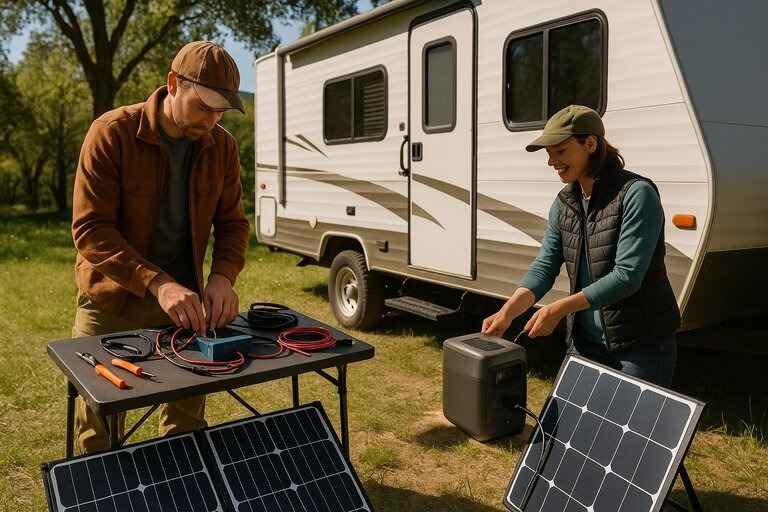
Exploring Sustainable Adventures: Solar Generators for RVs
As outdoor enthusiasts increasingly embrace off-grid camping and boondocking, the quest for renewable energy solutions has become paramount. Solar generators designed for RVs stand out as a sustainable option that allows campers to enjoy clean, quiet power while reducing their carbon footprint.
These eco-friendly devices not only facilitate a comfortable experience in nature but also support a broader push toward renewable energy adoption.
Understanding Solar Generators: Power Up Your RV
Choosing the right solar generator for your RV can seem daunting at first. Words like 'battery chemistry,' 'surge ratings,' and 'solar panel placement' might leave many scratching their heads. However, it’s vital to understand these details to ensure you are well-equipped for your adventures.
For instance, the difference between lithium-ion and lithium iron phosphate (LiFePO4) batteries can significantly influence your RV’s energy efficiency and lifespan.
The Sustainable Impact of Solar: A Deeper Look
When it comes to choosing a solar generator, it’s not just about power output or battery life anymore. More and more people are also thinking about how these products are made—and what kind of impact they have on the planet. That’s where sustainability comes in.
Some of the top names in solar power—like BLUETTI, Jackery, EcoFlow, and Goal Zero—aren’t just known for their cutting-edge technology. They’re also leading the way in ethical and eco-friendly manufacturing. These companies understand that today’s buyers, especially outdoor enthusiasts and campers, care deeply about reducing their footprint.
Take EcoFlow, for example. They go beyond just creating clean energy solutions. Their products are made with recyclable materials whenever possible, and the company has set goals to reduce waste and improve energy efficiency throughout their supply chain.
This means that when you invest in one of their generators, you're supporting a brand that shares your values—especially if you’re someone who loves nature and wants to protect it.
Jackery, another favorite among campers, has launched green campaigns and partners with environmental organizations to promote clean energy education and reforestation efforts. By choosing a Jackery unit, you’re not just getting a reliable backup power source—you’re also contributing to a bigger mission.
BLUETTI and Goal Zero also walk the talk. They emphasize long-lasting battery designs to cut down on electronic waste, and many of their products are built for repairability, so they don’t end up in landfills as quickly. Plus, they often use solar panels made from low-impact materials, helping keep harmful chemicals out of the production process.
When you’re planning your next camping trip or prepping for emergencies, choosing a solar generator that supports sustainability means you’re making a smart choice for both your lifestyle and the planet. It’s a small step that makes a big difference.
Hands-On Exploration: DIY vs. Plug-and-Play Systems

The debate between full DIY solar kits and plug-and-play solar generators is a common concern among RV owners. DIY systems offer customization, potentially saving some money if you’re handy and adventurous.
However, plug-and-play generators provide simplicity and convenience, making them appealing for those new to solar tech. Which option is right for you will depend on your comfort with technology and the intricacies of solar setups.
Boondocking Essentials: How Many Panels Do You Need?
If you're planning to boondock—meaning camping without hookups—you’ll need to be smart about how you manage your power. One of the biggest questions new boondockers ask is: How many solar panels do I need?
A good starting point is 200 to 400 watts of solar power. For many campers, that’s enough to run the basics like lights, phone chargers, fans, and maybe a small fridge. But the real answer depends on your setup and how much energy you use each day.
Think of your power use in terms of watt-hours. For example, if your coffee maker uses 600 watts and you run it for 10 minutes, that’s about 100 watt-hours. Add up everything you plan to use in a day—lights, water pump, phone chargers, laptops, and so on—and you’ll get a better idea of how much solar power you really need.
Also, think about how many people you’re camping with. A solo traveler will use way less power than a family of four. More people means more devices, more lights, and more time using the water pump or fans.
Here’s a simple way to plan:
200W of solar: Enough for minimal use—charging devices, some lights, and maybe a fan.
400W to 600W: Good for small RVs or couples using a fridge, lights, laptops, and occasional small appliances.
800W or more: Best for full-timers or families with heavier power use and bigger battery banks.
Don’t forget to match your solar setup with the right battery storage. Solar panels only work when the sun’s out, so you’ll need a battery bank to store that power for nighttime or cloudy days.
Once you dial in your solar system to match your needs, you’ll have the freedom to camp anywhere—no plugs required, no noisy generator—just clean, quiet solar power keeping everything running.
Examples Of Camping with Solar
Sometimes, the best way to understand the value of solar power is by hearing from people who actually use it on the road. These real-life stories paint a vivid picture of what it’s like to camp comfortably—and responsibly—off the grid.
Take Dani and Mark, for example, a couple who converted their camper van into a solar-powered tiny home. They often talk about their favorite campsite tucked away in the Colorado mountains.
No hookups. No noise. Just them, the trees, and their solar panels. “We watched the stars every night, made hot meals, and even charged our cameras to capture it all,” Dani said. “We didn’t have to run a noisy generator or worry about running out of fuel.”
Then there’s Alex, a solo traveler who spends weeks at a time boondocking in the desert. His setup includes 400 watts of solar panels and a solid battery bank. “It’s the little things,” he said. “Waking up with a hot cup of coffee brewed by sunlight—it just feels good. Like you’re part of something cleaner and simpler.”
Tasha and her two kids camp regularly along the California coast. With solar, she’s able to run a mini fridge, charge phones and tablets, and even use a small blender for morning smoothies. “Camping used to feel like a step down in comfort,” she shared. “Now it’s just a change of scenery—with all our essentials taken care of.”
These kinds of moments stick with you. Waking up to the smell of pine trees. Cooking breakfast while birds sing. Watching your solar generator quietly power everything behind the scenes—it turns camping into something more than just a trip. It becomes a lifestyle shift toward freedom, peace, and sustainability.
What’s even better? There’s no fuel to haul, no fumes to breathe, and no guilt about your impact on the environment. You’re using what nature gives you—sunlight—to enjoy nature itself.
The Future of RV Camping: Predictions and Trends
The future of RV camping is likely to be increasingly intertwined with advancements in solar technologies. As consumers become more aware of climate change and embrace sustainable choices, solar generators may become a must-have for RV enthusiasts. Innovations could include more efficient solar panels and longer-lasting batteries, making outdoor adventures more accessible and eco-friendly.
Take Action: Power Your Next Adventure Sustainably!
If you are considering a shift to an RV life infused with sustainable energy, now is the time! Research your options, and dive into the world of solar generators. Each choice you make helps forge a path to a healthier planet for future generations. Join the movement towards eco-friendly living and embrace your love for the outdoors responsibly!
 Add Row
Add Row  Add
Add 





 Add Row
Add Row  Add
Add
Write A Comment